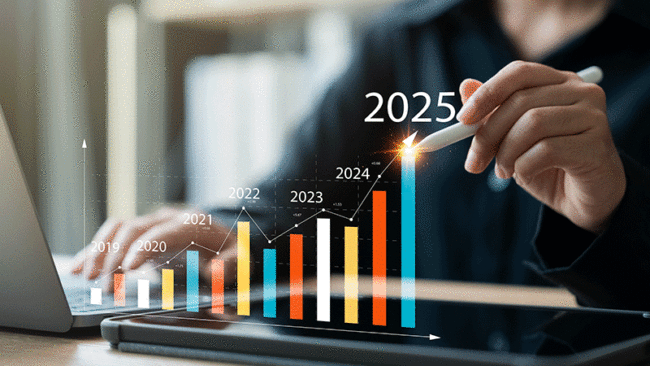Stay connected
Subscribe to our corporate payments blog to stay on top of payment innovations.

As 2024 winds down and we look ahead to 2025, the evolution of B2B payments shows no signs of slowing. Technological advancements and changing customer expectations are driving a new wave of payment innovation and shifting businesses towards digital transformation.
For businesses, staying ahead of these trends is important for maintaining smooth operations, building stronger relationships with suppliers and customers, and ensuring financial security.
In this article, we’ll discover the payment trends expected to shape B2B transactions in 2025 and how businesses can adapt to these changes.
Real-time payments, which enable instant money transfers between businesses, are set to dominate the B2B payment industry in 2025. In fact, according to a recent report by PYMNTS Intelligence and The Clearing House, 96% of manufacturers expect real-time payments to replace traditional checks for outgoing payments, while 87% foresee the same shift for receiving payments.
Traditionally, B2B transactions have been slow, with payments taking days or, in the case of checks, weeks to process. Real-time payments solve this problem by providing immediate settlement, which means businesses can receive and send funds faster than ever before. Quick transactions are important for several reasons:
For businesses looking to stay competitive in 2025, adopting real-time payment solutions is becoming less of an option and more of a necessity.
Virtual cards are on the rise in the B2B sector in 2025. In fact, according to Grand View Research, the global virtual card market was valued at $13.31 billion in 2022 and is expected to grow at a 20.9% annual rate (CAGR) from 2023 to 2030. Leading the charge is the B2B segment, which accounted for over 69% of the 2022 global revenue.
Virtual cards, which are generated for one-time or limited-use transactions, offer a layer of security and control that physical cards can’t match. Businesses can issue virtual cards to employees or partners, set spending limits, and track transactions in real time. This helps reduce the risk of fraud, encourage better expense management, and speed up business payments.
Virtual cards also offer an opportunity to generate additional revenue through rebates. Some providers, such as WEX, offer rebates that allow businesses to earn rewards on purchases made by employees or suppliers. These rebates can be reinvested into the business or used to offset expenses, providing a valuable source of additional income.
Businesses can expect to see virtual cards become a key tool in reducing financial risks and improving payment efficiency.
Visit the Payments 101 hub to learn more!
According to Juniper Research, the total number of digital wallet users will exceed 5.2 billion globally by 2026 – that’s more than half the global population.
Mobile wallets, once seen primarily as consumer tools, are now making their way into the B2B space. Platforms like Apple Pay, Google Pay, and even industry-specific solutions are becoming increasingly popular for business transactions. The convenience, security, and efficiency they offer make them an attractive option for companies looking to make their payment processes more efficient.
Mobile wallets offer unprecedented levels of convenience with their tap-to-pay capabilities and their growing acceptance. They eliminate the need for physical cards or checks, allowing for contactless payments and access with just a few clicks.
Given their convenience, they also offer enhanced security measures with many digital wallets using encryption, biometric authentication, and tokenization with virtual cards, making them more secure than traditional payment methods.
In 2025, more B2B companies will adopt digital wallets to handle everything from vendor payments to payroll, simplifying the payment experience for everyone involved.
Artificial intelligence (AI) is revolutionizing payment processes, and in 2025, it’s expected to play an even bigger role in automating B2B transactions. AI can help businesses streamline invoicing, accounts receivable, and accounts payable, allowing for faster and more accurate payments.
The recent PYMNTS 2024 Certainty Project Report, sponsored by WEX, emphasized the importance of AI in driving efficiency and reducing financial uncertainty in businesses today. The report found that, of the companies surveyed, firms using AI for most of their payments are 86% more likely to have payment options that help enable business growth compared to companies using minimal AI. This is because:
As we near the end of 2024 and approach 2025, B2B payment trends are all about speed, security, and efficiency. From real-time payments to AI automation, businesses have more tools than ever to streamline their financial processes.
By staying ahead of these trends, companies can improve their cash flow, strengthen supplier relationships, and reduce operational costs. The future of B2B payments is bright, and those who adapt will be well-positioned for success in the years to come.
For more insights and updates on corporate payments, check out:
Learn more about how WEX payment solutions can be tailored to your business, so you can accelerate and streamline operations while creating lasting growth and success for your organization.
Stay up to date on the latest in business payments by subscribing to our blog! Simply hit the “Subscribe” button above or submit your email address in the form below.
The information in this blog post is for educational purposes only. It is not legal or tax advice. For legal or tax advice, you should consult your own legal counsel, tax, and investment advisers.
Sources:
PYMNTS Intelligence and The Clearing House
IBM
Juniper Research
Grand View Research
PYMNTS
Subscribe to our corporate payments blog to stay on top of payment innovations.